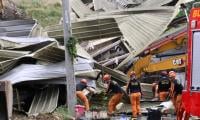Let’s revive the Quetta stove!
Rawalpindi
These days when there is a shortage of gas and the weather is cold I often wonder why we do not revert to using what used to be known as ‘Quetta Stoves’ and no, it’s not about going back to the dark ages, it about convenience; keeping warm and making the best of a bad situation!
Years ago, when gas was not discovered in Pakistan, people in Balochistan kept their homes warm with this contraption that was locally made by tinsmiths -- who work with tin to produce different household items.
Anyway, Quetta stoves were a rough version of cast iron stoves used in western countries, which are still in use in many areas. They had multiple uses -- they kept the rooms cosy; a kettle on the boil and you could keep your food warm on the surface. There was one danger though -- you had to be careful not to touch the tin and especially keep an eye on young
children so that they did not go near it and burn themselves.
The main requirement for a Quetta stove is a fireplace chimney or opening to the outside; wood of any kind; or sawdust or coal, of which either of the two kinds available in the market would serve the purpose. Though there are four kinds of coal, presumably only two of these are available and are known in local parlance as ‘Lakri ka coala; (wood coal) or ‘coke’ -- the hard, shiny kind.
Though not very fancy looking but easily removed for cleaning, these stoves were useful and convenient and made the room much warmer than a traditional wood fire, though of-course, they did not give the same feeling of comfort as visible flames do. They used to be round in shape -- as high and wide as you liked -- and had a large pipe, also made of tin, on one side to act as a flue, which was inserted in the fireplace -- or whatever outlet was being used - for the smoke to escape. If you wanted the stove a little removed from the fireplace or wall additional pipes were used to do the needful. A door was cut in the front to load the heating material; in some of them there used to be an iron mesh and a tray at the bottom for air and to catch the ash but generally there was no such addition. The pipe would pull the smoke up with suction and keep the fire lit, while the embers lasted for a long time. Naturally, the openings for the pipe and door were made ‘leak proof’ so that no smoke escaped and became a danger for those in the room -- coal gas can be deadly if inhaled.
Now I will go to look for a tinsmith and see whether he can recreate a Quetta stove from my description. There was nothing on the internet or any hand drawn illustration either and that means there is no record of them! Or maybe someone who does not have gas, somewhere in Baluchistan, still uses one. Who knows? It would be interesting to find out!
-
 Canadian PM Visits China After A Decade Of Diplomatic Strain: What Deals Are In Focus?
Canadian PM Visits China After A Decade Of Diplomatic Strain: What Deals Are In Focus? -
 New York Plans Limited Rollout Of Self-driving Taxis
New York Plans Limited Rollout Of Self-driving Taxis -
 Sarah Ferguson Faces Painful Choice Between Peace, Family Bond
Sarah Ferguson Faces Painful Choice Between Peace, Family Bond -
 Nvidia Clarifies ‘no Upfront Payment Needed For H200 Chips Production’
Nvidia Clarifies ‘no Upfront Payment Needed For H200 Chips Production’ -
 Africa First: Nigeria Set To Approve Landmark AI Rules For Digital Economy
Africa First: Nigeria Set To Approve Landmark AI Rules For Digital Economy -
 WhatsApp Tests Built-in Supervision Feature Long Missing From The App
WhatsApp Tests Built-in Supervision Feature Long Missing From The App -
 Iceberg A-23A Turns Blue As Scientists Warn Collapse Is Imminent
Iceberg A-23A Turns Blue As Scientists Warn Collapse Is Imminent -
 FIFA Selects Stats Perform For Betting Data And Live Streaming
FIFA Selects Stats Perform For Betting Data And Live Streaming -
 Is Jessica Simpson Really Joining 'The Bachelorette'?
Is Jessica Simpson Really Joining 'The Bachelorette'? -
 Brayden Point Injury Raises Concern After Early Exit For Tampa Bay Lightning
Brayden Point Injury Raises Concern After Early Exit For Tampa Bay Lightning -
 Meghan Trainor Addresses 'toxic Mom Group' Rumours Again
Meghan Trainor Addresses 'toxic Mom Group' Rumours Again -
 Mattel Autistic Barbie Doll Aims To Boost Representation And Inclusion
Mattel Autistic Barbie Doll Aims To Boost Representation And Inclusion -
 William Makes Calculated Move To Future-proof His Public Role Amid Harry Return
William Makes Calculated Move To Future-proof His Public Role Amid Harry Return -
 Elijah Wood Breaks Silence On Possible Return To New 'Lord Of The Rings' Film
Elijah Wood Breaks Silence On Possible Return To New 'Lord Of The Rings' Film -
 Aaron Rodgers Wife: What The NFL Quarterback Has Said About His Marriage
Aaron Rodgers Wife: What The NFL Quarterback Has Said About His Marriage -
 Buckingham Palace Shuts Down Claims It Can Step In On Harry’s Security
Buckingham Palace Shuts Down Claims It Can Step In On Harry’s Security



